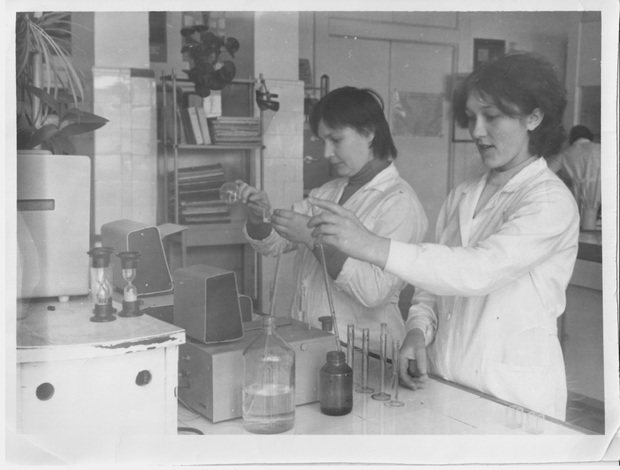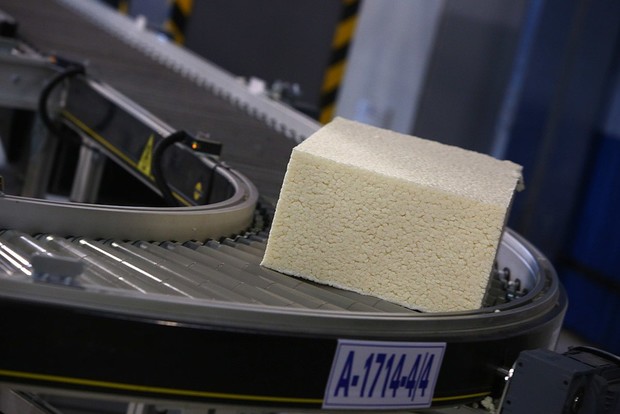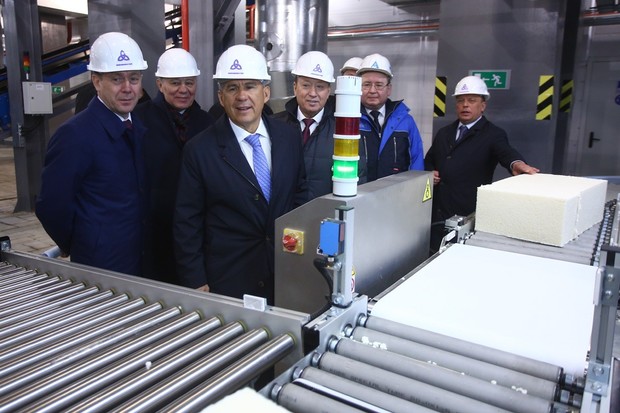Scientific Mecca for petrochemical Tatarstan
Research and Technology Centre of Nizhnekamskneftekhim as a linking chain between science and production
Implementation of own scientific elaborations guarantees a stable work any large petrochemical complex. For this reason, a mechanism of departmental special-purpose programmes, where the state takes risks of financing of Research Works and Research and Development, and business is responsible for work organization and guaranteed sales of products, was included in the development strategy of the petrochemical industry of Russia. The activity of the Research and Technology Centre (RTC) of Nizhnekamskneftekhim is an example of a mutually beneficial cooperation. The Centre has been elaborating new technologies in the sphere of quality improvement of a product, reduction of raw material and energy consumption, decrease of the number of stages of chemical processes and production of new kinds of products for 50 years. A correspondent of Realnoe Vremya found out the peculiarities and the importance of this work.
Import substitution centre
'I cannot wear this laurel wreath because it is a common success of the specialists of Plastic Plant and commercial service. My work maybe is about 30%,' Ildar Salakhov, a young scientist-petrochemist, said modestly answering a question about the share of science in the elaboration of new articles in Nizhnekamskneftekhim.
Being a four-year student of Nizhnekamsk Institute of Chemical Technology, Ildar decided to link his future profession with science. This is why the choice of the Scientific and Research Centre in the Nizhnekamsk monotown as a workplace was obvious. The graduated student joined a collective of scientists and worked on the elaboration of new types of synthetic rubbers till 2005, when a Polyolefin Laboratory was created on the basis of the Scientific and Research Centre, which he headed five years later.
A small collective of the laboratory, which consists of 9 people only, has over 50 marks of polypropylene under its belt for 10 years of elaborations. In addition, this indicator is a small part of the work of the Scientific Centre within the scope of the corporate programme on import substitution. They continue working in this area, which became especially topical in the current foreign economic situation connected with anti-Russian sanctions.
A simple example: more than 70,000 tonnes of polyethylene, which designed for insulation of gas and oil pipes, is delivered annually from Europe to Russia. It started to hit the wallets of refiners because of the high dollar and euro rates. Having studied the demand on the domestic market for this type of plastic, the Sales Department of NKNKH together with the polyolefin laboratory and specialists of Plastic Plant found a solution for Russian companies-refiners. And a new Russian type of polyethylene PE 6146 KM under Nizhnekamskneftekhim brand has appeared on the Russian market since 2015. The elaboration successfully recommended itself in the largest factories producing pipes for main gas and oil pipes. There is a great deal of such facts.
It takes from one to five years to create one type of plastic or rubber and start its mass production. The workers of the Scientific and Technology Centre and the specialists of NKNKH plants filed 80 applications for inventions and beneficial models. And Rospatent, Russian Federal Service for Intellectual Property, gave out 83 patents.
From a small laboratory to scientific Mecca
Just a few industrial enterprises of the country have their own scientific base. The Science and Technology Centre appeared in the composition of the Nizhnekamsk petrochemical factory one year before the first production, that is to say, in 1966. The first Potable Water Laboratory for the provision of Nizhnekamsk the chemical factory, which was under construction, appeared two years earlier. Graduated students of Kazan State University worked in the laboratory.

A rapid development of the chemical enterprise of Nizhnekamsk in the 60-70s favoured a high activity of the researchers and innovators of the first laboratory of the future Science and Technology Centre: measurement procedures were elaborated, examinations of systems and equipment were carried out, a new direction – research work – arose.
From 1970, the workers of the central laboratory started to file many applications for inventions. By the way, the first inventor's certificate of the USSR called Protection Means of Black Metals from Corrosion in Neutral Water Environment was given to a group of authors headed by Candidate of Technical Science A.Orekhov in 1973. So, the head of Corrosion Laboratory of the Nizhnekamsk Chemical Factory became the owner of a VDNKH silver medal, and his name is in books about corrosion of metals.

The laboratory gradually grew into Administration of Scientific, Research and Development Elaboration and Introduction, which was granted a status of Science and Technology Centre in 1997. Today STC has 12 research laboratories and experimental and industrial shop on hydrocarbon production and its compounds.
In 2009, when the director general of NKNKH Vladimir Busygin visited STC and gave a new status to it – Scientific Mecca. So, he defined the gist and the importance of the centre for the enterprise.
285 workers are creating the future of the petrochemical enterprise: over 100 engineers-researchers, one doctor and 22 candidates of science. They are the authors of tens of scientific elaborations protected by Russian Patent Law and presented in Russian and international conferences, academic conferences and contests. The workers of the centre are working on the quality improvement of the indicators of the products manufactured and raw material delivered every day. Up-to-date and precision equipment help them in this work.
The pilot plant of STC is worthy of special attention: this the only in Russia exploratory equipment is aimed at the production of new types of world quality rubber. This universal scientific and technological site, in fact, defines the development perspective of the petrochemical giant.
STC pays much attention to ecological issues. Laboratories of the centre successfully deal with the tasks on the selection of methods for wastewater, air and industrial gas emission purification. A close and constant partnership of scientists of NKNKH with their colleagues from Kazan Federal University, Kazan National Research Technology University, science and research centres in Moscow, St. Petersburg, Voronezh and Novosibirsk provides a high standard of works in this sphere.
By the by, at the beginning of April, STC will become a scientific centre of Russia: 9th International Conference dedicated to the 50th anniversary will be held on the basis of the Centre. Representatives of scientific organizations of the country and foreign scientists will discuss topical problems and the actual state of the innovation development of the petrochemistry.
First and only in Russia
STC has been yielding fruits for Nizhnekamskneftekhim for 50 years. The achievements of the workers of the Science and Technology Centre are endless. But there are special elaborations among hundreds of advanced projects, which won the glory not only the scientists but also all company. First of all, it is halobutyl rubber (IIR).
Due to hard efforts and searches of the necessary formulation, the petrochemists of Nizhnekamsk were the first in Russia and third in the world (after Exxon and Bayer) who started to produce IIR of two kinds – chloributyl and brombutyl rubbers – in 2003. Nowadays NKNKH continues holding this position.

In 2007, the Centre was awarded a grant of the government of the Russian Federation equal to 705m rubles for the development of technologies of new rubbers. These funds became an additional motivation for the achievement of new significant scientific results. Speaking more precisely, elastomer production unit was erected by means of this grant. The unit, which consists of nine modules, enables to model all stages of industrial production of synthetic rubbers. As a result of the use of a unique equipment, production technologies of such synthetic rubber as ethylene propylene rubber (EPM), butadiene rubber based on a lithium catalyst (Li-BR) and styrene-butadiene (SBR) were developed in the short run. They all have valuable properties that are necessary for tyre production, rubber goods and plastic modification. For example, the use Li-BR in the process of high-impact polystyrene production allowed to reduce its prime cost.
The scientists of STC developed production technologies of two kinds of SBR using this unit: the first is used as a raw component for ABS plastic production, and the second – for the tyre industry. Low rolling resistance tyres are made of this type of rubber. Protectors of these tyres have wet traction enhancements, are more resistant to wear, and 'allow to save 10% of fuel because of a low rolling resistance, what is also important. It means that car exhausts reduced too. Nowadays we have researches on technology production of SBR of a new generation,' the director of STC Igor Belanogov specifies.
The director of STC Igor Belanogov: 'Nowadays STC has researches on technology production of new generation SBR'
As for another important project carried out in STC within the scope of import substitution programme, erection of a new mini-unit, which is based on pilot plant, began in last year's December. It will produce a complicated product – neodymium neodecanoate. It is one of the component of a multicomponent catalyst complex, which is necessary for another type of rubber – polybutadiene rubber.
Today polybutadiene rubber is produced too much, so that the volumes of neodymium neodecanoate produced with the mini-unit, which became morally old, were not enough. The capacity of the unit will increase by 50% due to new equipment, so the capacity will grow to 300 tonnes of neodymium neodecanoate per year. At present, NKNKH buys the lacking volumes from abroad and misses much money because of extremely high prices.
The transfer to its own production is very profitable for the company. 'Moreover, the payoff term of the projects won't exceed a year from the start of the construction of the unit because of the high price of the product,' the head of STC notes. 'If the start of production is a starting point, it will take just 3 months.'
Science and production entwined
Heads of plants, who are closely working with the specialists of the Centre, also tell about the importance of the activity of the Science and Technology Centre. 'The Science and Technology Centre is that motivation of the progress for Halobutyl Rubber Plant. The factory is intermittently developing in the conditions of lightning changes in technology thanks to the high qualification of the workers of the Centre and rich experience in the segment of polymers,' the director of Halobutyl Rubber Plant Irek Aglyamov tells.

According to Aglyamov, a vein of innovation and thirst for knowledge help the collective of the Science and Technology Centre to move at rapid-fire pace from one fulfilled task to another. 'All work of the collective of scientists is an engine of the development of both the factory and NKNKH in general. And the figures, final reports of the enterprise is the result of the work of the enterprise: revenue is growing, profit is increasing and every worker's well-being respectively,' Irek Aglyamov concludes.
Almost every article out of 120 goods, which NKNKH is producing today, has a scientific idea of the workers of the STC. Ties of science and production are very close here.
Especially today in the current economic conditions, when import substitution is not just on paper but a necessity. Use of new technologies and materials, catalysts, which are designed not only to substitute foreign analogues but also reduce the price cost of the products of NKNKH, depends on the workers of the Centre. As the head STC admits, today probably there is no problem that would not be within the power of the 'scientific Mecca' of Nizhnekamskneftekhim.